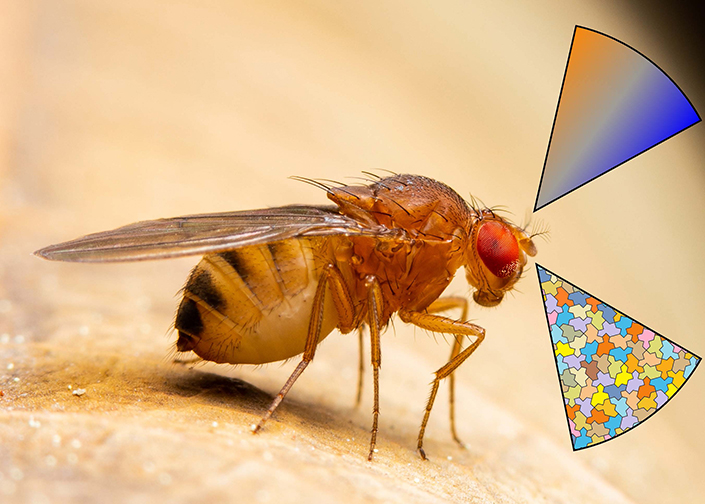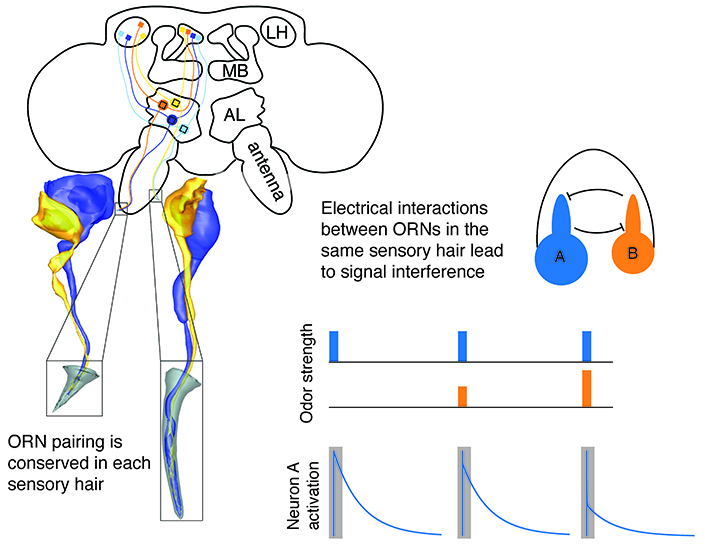Detecting Odors on the Edge: Researchers Decipher How Insects Smell More with Less
Receptors on fly antennae work in pairs to process vital odor information
Story by:
Published Date
Article Content
Whether it’s the wafting aroma of our favorite meal or the dangerous fumes seeping from a toxic chemical, the human sense of smell has evolved into a sophisticated system that processes scents through several intricate stages. The brains of mammals have billions of neurons at their disposal to

Insects such as fruit flies, on the other hand, have a mere 100,000 neurons to work with. Yet their survival is dependent upon their ability to decipher the meaning of complex odor mixtures around them to locate food, seek potential mates and avoid predators. Scientists have pondered how insects are able to smell, or extract information from odors, with a much smaller olfactory sensory system compared with mammals.
Scientists at the University of California San Diego believe they have an answer to this puzzling question. Palka Puri, a physics Ph
“Our work sheds light on the sensory processing algorithms insects use to respond to complex olfactory stimuli,” said Puri, the first author of the paper
Previous investigations of the odor processing system in flies focused on the central brain as the main hub for processing odor signals. But the new study shows that the effectiveness of the insect’s sensory capabilities relies on a “pre-processing” stage in the periphery of their sensory system, which prepares the odor signals for computations that occur later in the central brain region.
Flies smell through their antennae, which are replete with sensory hairs that detect elements of the environment around them. Each sensory hair usually features two olfactory receptor neurons, or ORNs, that are activated by different odor molecules in the environment. Intriguingly, ORNs in the same sensory hair are strongly coupled by electrical interactions.
“This scenario is akin to two current-carrying wires placed close together
In the case of the fly olfactory system, however, this interference is beneficial. The researchers showed that as flies encounter an odor signal, the specific pattern of interference between the receptors helps flies quickly compute the “gist” of the odor’s meaning: “Is it good or bad for me?” The result of this preliminary evaluation in the periphery is then relayed to a specific region in the fly’s central brain, where the information about odors present in the outside world is translated to a behavioral response.
The researchers constructed a mathematical model of how odor signals are
“Remarkably, our work shows that the optimal odor blend — the precise ratio to which each sensory hair is most sensitive — is defined by the genetically predetermined size difference between the coupled olfactory neurons,” said Aljadeff, a faculty member in the School of Biological Sciences. “Our work highlights the far-reaching algorithmic role of the sensory periphery for the processing of both innately meaningful and learned odors in the central brain.”
Aljadeff describes the system with a visual analogy. Like a specialized camera that can detect specific types of images, the fly has developed a genetically driven method to distinguish between images, or in this case
“We discovered that the fly brain has the wiring to read the images from this very special camera to then initiate behavior,” he said.
To arrive at these results, the research was integrated with previous findings from Su’s lab that described the conserved organization of ORNs in the fly olfactory system into sensory hairs. The fact that signals carried by the same odor molecules always interfere with each other, in every fly, suggested to the researchers that this organization has meaning.
“This analysis shows how neurons in higher brain centers can take advantage of balanced computation in the periphery,” said Su. “What really brings this work to another level is how much this peripheral pre-processing can influence higher brain function and circuit operations.”
This work may inspire research into the role of
“These findings yield insight into the fundamental principles of complex sensory computations in biology, and open doors for future research on using these principles to design powerful engineered systems,” said Puri.
Supporters of the research included the Defense Advanced Research Projects Agency (D21AP10162-00), the Department of Energy (DE-SC0022042), the National Institutes of Health (R01NS135853, R21AI169343, R21DC020536 and R01DC016466) and the Kavli Institute for Brain and Mind at UC San Diego.

Share This:
You May Also Like
Stay in the Know
Keep up with all the latest from UC San Diego. Subscribe to the newsletter today.



